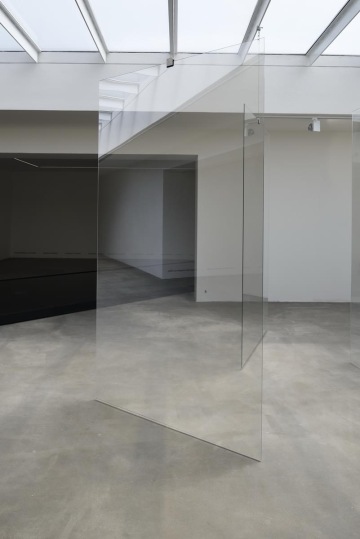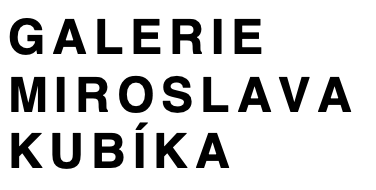VÁCLAV CIGLER MICHAL MOTYČKA / GLASS / Optical properties of glass
The text OF JANA ŠINDELOVÁ ON THE INSTALLATION OF VÁCLAV CIGLER AND MICHAL MOTČKA / GLASS / OPTICAL PROPERTIES OF GLASS
Optical Properties of Glass
Václav Cigler and Michal Motyčka have prepared an installation simply titled Glass, which presents their joint thinking on many levels, from the sensory experience of the perception of a given space to the understanding of implicit symbolic meanings and optical changes of glass sculptures in a gallery environment. Using the words of Václav Cigler: „Glass is a magical, and in some sense spiritual, material. Optical glass, which I have been working with since the late 1950s, is a material that has been developed for technical and scientif ic purposes. Working with it, one can discover the secrets of the micro and macro world and see a world that is different from the world one sees with the naked eye. The optical properties of glass are therefore artistic and aesthetic means for me with the help of which I can introduce to the viewer a world featuring new shapes, lights and colours.“
The exhibited works are transparent objects, elementary forms of prisms and cylinders made of optical glass. They create sensory and architectural relationships using compositions based on element sorting, change of horizon perception, and the gate composition principle. The horizon defined by the onlooker‘s view changes with the change of prism bevel angles. Close to the gate, the edges of two slanting blocks converge to the centre and form a narrow slot. Light transforms the shapes of objects, radiates and distorts their exact forms. Through the installation, the authors attempt to change the perception of space by the viewer. In his artistic work, Václav Cigler has been working on glass sculptures since the late 1950s, as the first artist he discovered the potential of optical glass developed for technical and scientific purposes and began using it for the creation of works of art. He was selected to participate in major international exhibitions (1959 at the Corning Museum of Glass in Corning, USA, 1957 and 1960 at the 11th and 12th Triennial in Milan, Expo 58 in Brussels, 1964 at the Museum of Contemporary Crafts of the American Craftsmen‘s Council in New York) and at the Expo 67 in Montreal, where his prism sculpture was for the first time awarded an international recognition.
Isaac Newton also experimented with the optical properties of prisms. Trying to determine the nature of light, he was able to decompose white light into a rainbow spectrum and merge it again, thereby refuting Aristotle’s theory, who claimed that white light is substantially pure. Václav Cigler and Michal Motyčka present prisms and cylinders made of optical glass that precisely formulate space and, with the help of a visual installation, develop a minimalist story of a symbolic shape - together with the physical presence of the viewer. They deal with the issue of optical displaying but also with a more serious reflection on the nature of light and the perception of colours, simply with experimenting with our senses. The site-specific installation located between floors in the courtyard of the château intersects a closed space with a levitating vertical in the form of a metal needle that attacks the viewer and visually connects space in the sense of what is going on above and below. The objects having a seemingly simple geometric shape are enhanced by the events and actions of this light, colour and shape-changing environment gallery space.
Optical glass is glass of the very highest quality. Its production requires the greatest level of skill and precision, and its cost is subsequently far greater than the cost of any other glass in the world. Optical glass is made using the same raw materials as ordinary glass, but its production requires a far more rigorous process and the finest ingredients in order to achieve its remarkable purity. In fact, only three European countries – France, Italy, and the Czech Republic – have sand of great enough purity to be used for its manufacture. Its essential ingredients are sand, soda, potash, and lime. Special chemicals are then added to give the glass its characteristic hardness, resistance, transparency, and high refractive quality. The glass is only produced industrially in large furnaces, and technologies have to be employed that ensure the glass will be absolutely pristine. For example, the tanks used for melting the glass are lined with platinum so that no particles from the furnace’s walls enter the molten glass, causing unwanted coloring, bubbles, grit, or other flaws. Once the glass is melted, it is poured out of the furnace onto a conveyor belt for cooling, where it rests for lengths of time ranging from as little as eight hours to several days, depending on the thickness of the blocks. Conventionally, optical glass is used for precision instruments, such as lenses for cameras, microscopes, and telescopes (the largest optical glass lens in the world is part of the Hubble Space Telescope).
The purity of the glass naturally lends itself to Cigler’s pure, Minimalist forms. He experimented widely with the glass, first attempting to transfer ideas that had originally been planned for sculpture in more traditional media. Typically, Cigler begins with simple pencil sketches, his hand tracing the initial concept and its evolution in his thought. Due to the extreme precision required when working with optical glass, he subsequently reviews every step of the technical process – including the object’s shape, size, surface, and color. Objects made in optical glass and worked by hand are limited by weight and dimension, as there is only so much that can be done manually at this level of immensely refined craft while still keeping the integrity of the glass in its purest state. No more than 50 kg. is possible. For some works that incorporate several parts, such as Cigler’s columns, an additional technology comes into play at the end of the process. This technology involves vacuum coating the surface of the glass with various metal oxides, and then gluing the parts together with sophisticated adhesives. Blocks of optical glass are bought at considerable cost from a handful of international manufacturers with the capabilities and resources necessary to produce glass of this quality – such as the German –based Schott and Corning in the United States. Before the glass is re-melted, Cigler creates a wood or plaster model. The model is then used to cast a mold composed of siliceous sand and plaster (and sometimes also fireclay), which is reinforced with wire netting and metal fittings. The block of optical glass is laid inside the mold and then re-melted in an electric furnace. The mold has to be completely dry - any water would create bubbles in the glass and render it worthless. Each mold is used just once, as the heat of the furnace causes it to disintegrate once the process is completed. Exact calculations are made for what is called the “melting curve,” the precise temperature at which the melting glass fits the mold as closely as possible. Depending on the size of the piece, the temperature of the furnace ranges from 800 to 1200 degrees Centigrade. The process of reshaping the glass in the mold is excruciatingly slow: the shortest time is 14 days, the longest can be as much as six weeks. The completion of this stage is followed by the process of optical grinding. Sometimes this means refining the object’s shape with a glass saw fitted with a diamond blade, which is expensive but reduces the overall time needed to work the material. Hand grinding comes next; this is another lengthy process that involves the use of increasingly finer abrasives to refine and polish the surface of the glass. The glass is thoroughly washed after each step in this process, and even the craftsman’s hands and clothes have to be cleaned in order to ensure that not a single grain of the coarser abrasive used during the previous stage remains on the glass. This would cause the glass to become scratched, and the whole grinding process would have to be started again. Depending on the design, the finished piece is left matte or is highly polished, using felt or polyurethane discs and cerium polishing powder. The entire grinding process requires complete concentration, accuracy, a good eye, physical fitness, and time. Errors mean irreparable damage.
To create Václav Cigler’s and Michal Motyčka’s pieces, must use the most exacting techniques and technologies, and the purest glass in the world. But the very nature of their art and all of its aesthetic and philosophical issues demand it.
Jana Šindelová

